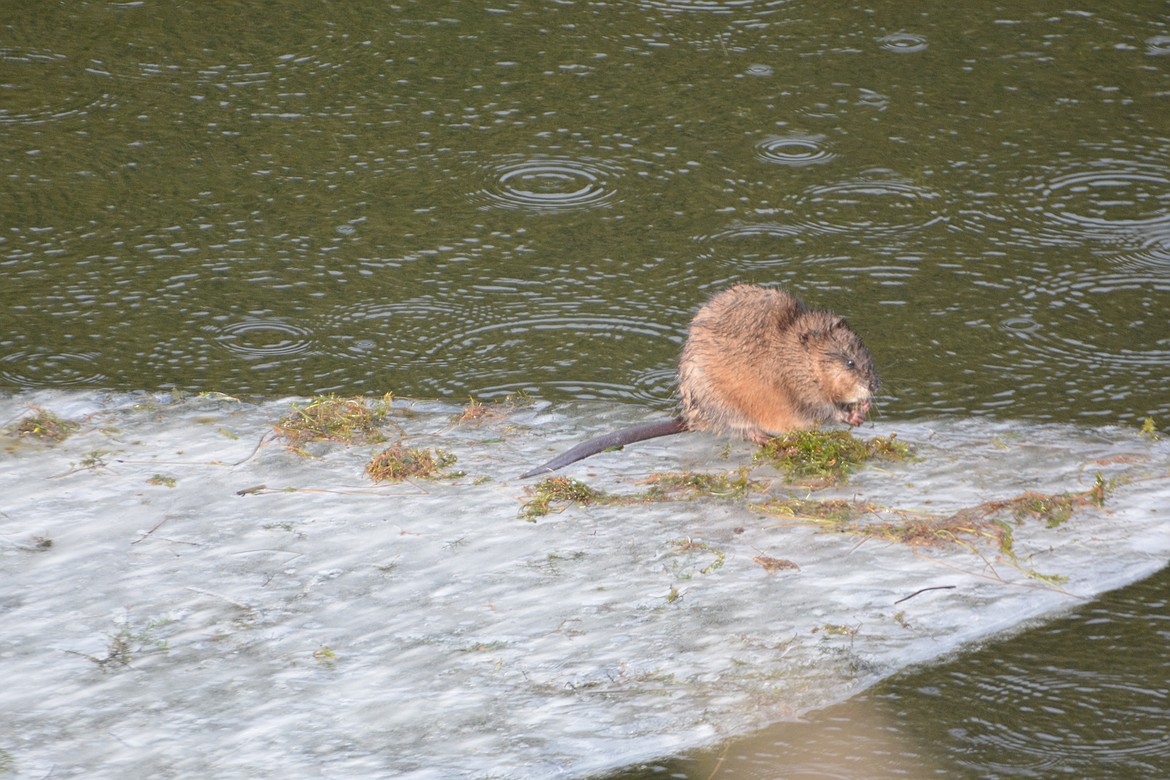Muskrats adapt well to winter in Boundary County
Don Bartling Contributing Writer | Hagadone News Network | UPDATED 5 years, 11 months AGO
On a cloudy, rainy morning beside a calm flowing creek I spotted a fur-bearing animal, smaller than a beaver, busily eating on the side of the creek bank while sitting on ice.
I took a few photos quickly, worried that I might scare him, but he was too busy eating to notice me so I enjoyed photographing him as he devoured his grassy meal. Then the primarily nocturnal animal with the squeaky voice slipped into the icy water and disappeared from sight. Although the rodent tends to be a social animal, there was only one other muskrat in the visible area.
Muskrats get their common name from their resemblance to stocky rats and from the musky odor produced by their scent glands. They are semi-aquatic and prefer locations with four to six feet of water. Muskrats are found in ponds, lakes, and swamps, but their favorite locations are marshes, where the water level stays constant.
Marshes provide the best vegetation for eating and constructing nests and burrows. Muskrats find shelter in bank burrows and nests that they build. Bank burrows are tunnels excavated in a bank. Nests are made by piling vegetation on top of a solid base, for example a tree stump, generally in 15 to 40 inches of water.
They have large, robust bodies, with a total body length of 12-24 inches. The tail is long, skinny, scaly and with flat sides and is generally 8-11 inches in length. Muskrats have dense fur that traps air underneath for insulation and buoyancy. Their heads are very large and their ears are almost invisible underneath the fur. Muskrats have short legs and big feet; their rear feet are webbed for swimming. Adult muskrats have glossy upperparts that are dark brown, darker in winter and paler in the summer.
Muskrats live in large family groups with definite territories. If conditions are crowded, females will kick their offspring out of the group. Muskrats continue to live in large groups even when they fight amongst themselves. Muskrats are active at all times of the day but most active from mid-afternoon until just after dusk, and at night. They paddle with their large, webbed rear feet and use their long, flat, and scaly tail to change their direction. Muskrats move slowly on land. They are affected by quick changes in temperature, and dry, hot weather is especially bad for them. Their homes and burrows protect them from the elements.
Muskrats communicate by a secretion from their glands called musk. This scent also serves to warn intruders. They are capable of vocalizing by squeaks and squeals. Muskrats have poorly developed senses of sight, hearing, and smell.
These musky rodents are mainly vegetarians but will eat animals as well. Muskrats consume about one-third of their weight every day. Their digestive system is designed for green vegetation. In the summer they eat the roots of aquatic plants. In the winter, they swim under the surface ice to get to the plants. Muskrats also eat agricultural crops.
Raccoons and river otters are their main enemies, although they are also preyed upon by coyotes, owls, minks, foxes, wolves, lynx, bobcats, bears and eagles.
Muskrats and beavers are the only mammals that build their home in the water. Unlike the beaver, however, the muskrat does not store food for the winter. It needs to eat fresh plants each day, and sometimes it makes channels in the mud to get from its house to reach food under the ice. To stay warm in winter, groups of muskrat huddle together in their lodge.
Muskrats are excellent swimmers and can evade many predators by escaping into water or into their burrows and nests. They can remain underwater for up to 15 minutes.
Although muskrats have been known to live up to 10 years in captivity, they are thought to live about three or four years in the wild.
Discover the beauty of Boundary County. Enjoy the outdoors!
ARTICLES BY DON BARTLING CONTRIBUTING WRITER

About the Douglas fir
“The big tree is nature’s forest masterpiece, and so far as I know, the greatest of living things.” — John Muir 1838-1914 “Father of the National Parks” and author.

Winter on the hoof: How deer, elk and moose cope with the snow!
“When snow falls, nature listens.”




